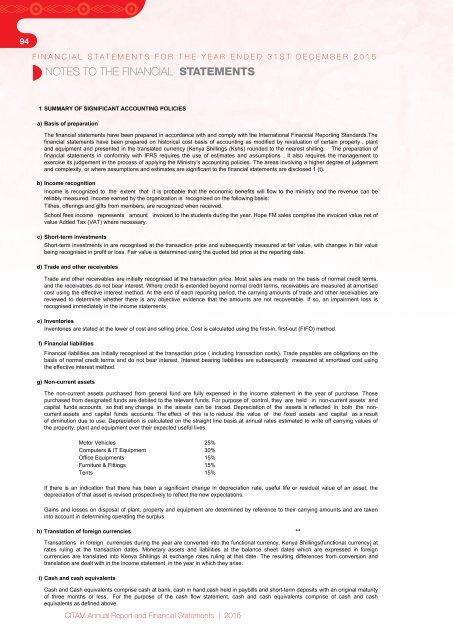2015 REPORT FINAL1
Create successful ePaper yourself
Turn your PDF publications into a flip-book with our unique Google optimized e-Paper software.
94<br />
FINANCIAL STATEMENTS FOR THE YEAR ENDED 31ST DECEMBER <strong>2015</strong><br />
NOTES TO THE FINANCIAL STATEMENTS<br />
CHRIST IS THE ANSWER MINISTRIES (CITAM)<br />
NOTES TO THE FINANCIAL STATEMENTS FOR THE YEAR ENDED 31ST DECEMBER <strong>2015</strong><br />
1 SUMMARY OF SIGNIFICANT ACCOUNTING POLICIES<br />
a) Basis of preparation<br />
The financial statements have been prepared in accordance with and comply with the International Financial Reporting Standards.The<br />
financial statements have been prepared on historical cost basis of accounting as modified by revaluation of certain property , plant<br />
and equipment and presented in the translated currency (Kenya Shillings (Kshs) rounded to the nearest shilling. The preparation of<br />
financial statements in conformity with IFRS requires the use of estimates and assumptions . It also requires the management to<br />
exercise its judgement in the process of applying the Ministry's accounting policies. The areas involving a higher degree of judgement<br />
and complexity, or where assumptions and estimates are significant to the financial statements are disclosed 1 (t).<br />
b) Income recognition<br />
Income is recognized to the extent that it is probable that the economic benefits will flow to the ministry and the revenue can be<br />
reliably measured. Income earned by the organization is recognized on the following basis:<br />
Tithes, offerings and gifts from members, are recognized when received.<br />
School fees income represents amount invoiced to the students during the year. Hope FM sales comprise the invoiced value net of<br />
value Added Tax (VAT) where necessary.<br />
c) Short-term investments<br />
Short-term investments in are recognised at the transaction price and subsequently measured at fair value, with changes in fair value<br />
being recognised in profit or loss. Fair value is determined using the quoted bid price at the reporting date.<br />
d) Trade and other receivables<br />
Trade and other receivables are initially recognised at the transaction price. Most sales are made on the basis of normal credit terms,<br />
and the receivables do not bear interest. Where credit is extended beyond normal credit terms, receivables are measured at amortised<br />
cost using the effective interest method. At the end of each reporting period, the carrying amounts of trade and other receivables are<br />
reviewed to determine whether there is any objective evidence that the amounts are not recoverable. If so, an impairment loss is<br />
recognised immediately in the income statements<br />
e) Inventories<br />
Inventories are stated at the lower of cost and selling price. Cost is calculated using the first-in, first-out (FIFO) method.<br />
f) Financial liabilities<br />
Financial liabilities are initially recognised at the transaction price ( including transaction costs). Trade payables are obligations on the<br />
basis of normal credit terms and do not bear interest. Interest bearing liabilities are subsequently measured at amortised cost using<br />
the effective interest method.<br />
g) Non-current assets<br />
The non-current assets purchased from general fund are fully expensed in the income statement in the year of purchase. Those<br />
purchased from designated funds are debited to the relevant funds. For purpose of control, they are held in non-current assets and<br />
capital funds accounts, so that any change in the assets can be traced. Depreciation of the assets is reflected in both the noncurrent<br />
assets and capital funds accounts. The effect of this is to reduce the value of the fixed assets and capital as a result<br />
of diminution due to use. Depreciation is calculated on the straight line basis at annual rates estimated to write off carrying values of<br />
the property, plant and equipment over their expected useful lives.<br />
Motor Vehicles 25%<br />
Computers & IT Equipment 30%<br />
Office Equipments 15%<br />
Furniture & Fittings 15%<br />
Tents 15%<br />
If there is an indication that there has been a significant change in depreciation rate, useful life or residual value of an asset, the<br />
depreciation of that asset is revised prospectively to reflect the new expectations.<br />
Gains and losses on disposal of plant, property and equipment are determined by reference to their carrying amounts and are taken<br />
into account in determining operating the surplus.<br />
h) Translation of foreign currencies<br />
Transactions in foreign currencies during the year are converted into the functional currency, Kenya Shillings(functional currency) at<br />
rates ruling at the transaction dates. Monetary assets and liabilities at the balance sheet dates which are expressed in foreign<br />
currencies are translated into Kenya Shillings at exchange rates ruling at that date. The resulting differences from conversion and<br />
translation are dealt with in the income statement in the year in which they arise.<br />
i) Cash and cash equivalents<br />
Cash and Cash equivalents comprise cash at bank, cash in hand,cash held in paybills and short-term deposits with an original maturity<br />
of three months or less. For the purpose of the cash flow statement, cash and cash equivalents comprise of cash and cash<br />
equivalents as defined above.<br />
CITAM Annual Report and Financial Statements | <strong>2015</strong><br />
10


